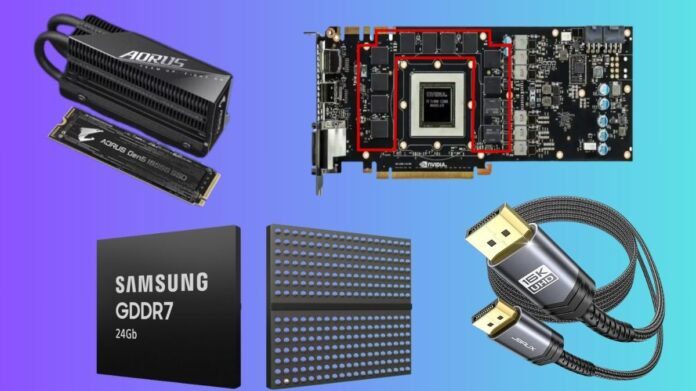How PCIe 5.0, GDDR7, and Displayport 2.1 Cable Redefine Performance
In the age of high-speed computing, PCIe 5.0, high-capacity GDDR7 ,VRAM, and DP 2.1 may deliver excellent performance and a wide range of applications.
This article discusses edge computing technologies’ primary features, end-user uses, and benefits.
Core Technical Features and Applications
Double-bandwidth, low-latency, high-speed PCIe 5.0
Technical Features
Double Bandwidth: PCIe 5.0 can transfer data at 32 GT/s, while x16 systems can reach 128 GB/s.
Low Latency: Improves data communication between devices, reducing latency for real-time processing applications.
Backward compatibility: PCIe 4.0 and 3.0 provide seamless upgrades and compatibility with SSDs and GPUs.
Advantages and Applications
- In large games like Elden Ring, real-time ray tracing and high-frame-rate gaming provide seamless 4K gameplay, improving immersion.
- AI Model Training: Quickens data access, increasing the pace at which huge, intricate AI models may be inferred.
- Edge Computing Data Processing: Supports distributed computing applications by increasing the efficiency of real-time data processing.
GDDR7: High-Bandwidth, Low-Power Memory Technology
Technical Details
Increased Memory Bandwidth: Up to 50% more bandwidth allows for faster rendering and read/write performance.
Low Power Consumption: Increased energy efficiency improves system stability while lowering heat generation.
Advantages and Applications
- Realistic graphics are improved by faster real-time ray tracing in Cyberpunk 2077.
- Content Creation and Rendering: Reduces 3D animation and effect processing time, increasing productivity.
- Reduces data processing time for AI model training and inference.
Ultra-high resolution and refresh rates with Displayport 2.1 Cable
Technical Details
Ultra-High Resolution and Refresh Rate Support: multi-screen 8K displays up to 240 Hz and 16K resolutions.
Improved Compatibility: It supports previous DP standards such DP 1.4, making it easier to connect to many display devices.
Advantages and Applications
- Professional gamers will enjoy responsive gameplay on future 4K 240Hz panels.
- Professionals and content creators can stream, game, and edit on many HD monitors.
High-Capacity VRAM: Overcoming Multitasking Bottlenecks
Technical Features
Large Storage Capacity: Prevents memory bottlenecks and is perfect for complicated 3D graphics, high-resolution gaming, and extensive AI training.
Improved Multitasking: Manages several VRAM-demanding programs, increasing productivity.
Benefits and Uses
- Multitasking and Data-Intensive Applications: When playing games, streaming, or even editing videos, gamers and professional creators may multitask with ease.
- Superior Gaming Experience: Take pleasure in intricate virtual environments in captivating 8K in contemporary games such as Microsoft Flight Simulator 2024.
- AI Research and Development: For quick training and inference, load and train massive Large Language Models (LLMs) locally.
Advantages and Applications of Next-Gen Technologies for Gaming, AI, and More
The Ultimate High-End Gaming Experience
Applications: Providing gamers that want the highest level of visual fidelity and fluid gameplay with excellent experiences.
Benefits:
- PCIe 5.0: Fast data transport that facilitates effective rendering.
- GDDR7: Increases rendering efficiency and speed.
- High-Capacity VRAM: Prevents stuttering by supporting even massive, high-resolution game assets.
- DP 2.1: Supports high-resolution, high-refresh-rate outputs of the future.
- Examples include using Cyberpunk 2077’s Ray Tracing and Starfield’s maximum settings with HDR enabled to explore the depths of the universe.
Increasing Professional Content Creators’ Productivity
Applications include managing 3D model design, special effects, and high-resolution films.
Benefits:
- GDDR7 and High-Capacity VRAM: Enhance rendering speed by processing large-scale materials quickly.
- PCIe 5.0: Improves overall productivity and efficiency by reducing data transmission bottlenecks.
- DP 2.1: Makes it possible for next-generation professional displays to use contemporary display outputs.
- Examples include using Blender to create intricate animations and DaVinci Resolve to edit 8K films.
An Effective Instrument for AI/ML Scholars
Applications: Developing sizable Machine Learning (ML) models to facilitate quick computation and inference.
Benefits
- PCIe 5.0: Increases the speed at which data moves between the GPU and storage.
- Large volumes of training data and intricate model parameters are stored in high-capacity VRAM.
- GDDR7: Speeds up training by cutting down on data processing delays.
- Examples include using TensorFlow to train GPT models and AlphaFold to predict biological structures.
Effective Solutions for Users of Edge Computing
Applications: Dispersed applications that need to process data and make decisions in real time.
Benefits:
- High-speed data access and transfers are made possible by PCIe 5.0 and GDDR7, which satisfy real-time computing requirements.
- High-Capacity VRAM: Enhances privacy and lessens dependency on the cloud by supporting complicated models on edge devices.
- High-quality display outputs for management and monitoring are made possible by DP 2.1.
- Examples include instantaneous customer flow analytics and feedback in retail establishments and real-time fault detection in industrial equipment.
The Benefits of Integrating Next-Gen Technology
High-capacity VRAM, PCIe 5.0, GDDR7, and DP 2.1 can be combined to provide unparalleled support for use cases in edge computing, professional video production, high-end gaming, and AI research.
These apps will be able to satisfy the increasing expectations for performance by providing high-speed data transmission, excellent image quality, and effective multitasking, all while offering real-time capabilities and guaranteeing data security.
The increasing demand for efficiency and high-performance computing across a number of industry verticals can be perfectly met by this technological synergy.


